TEN PLAGUES FABLE
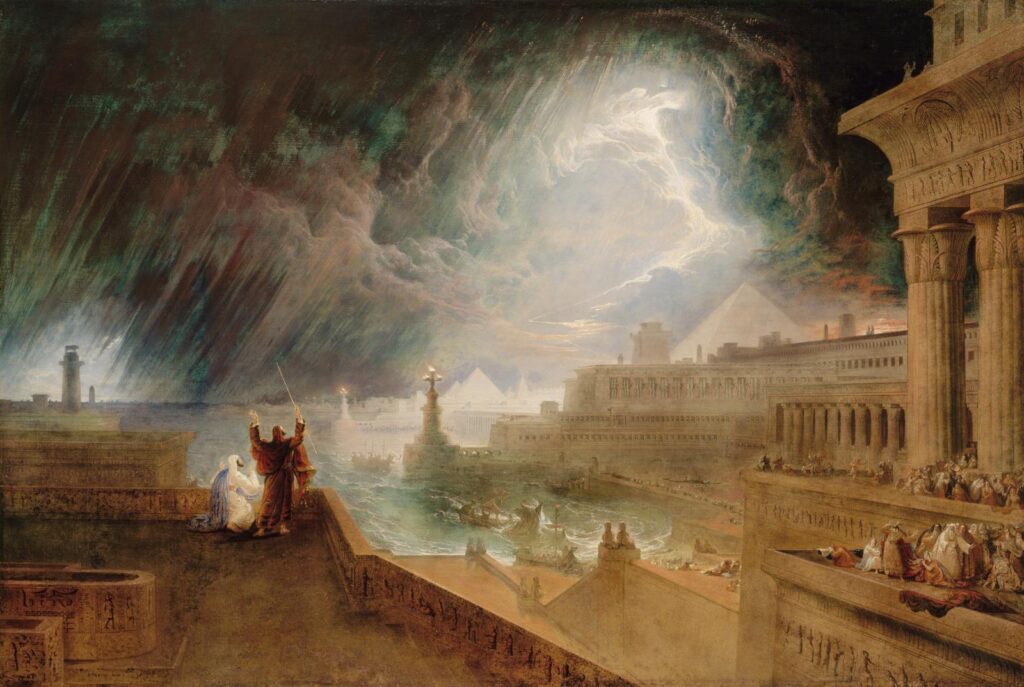
SO MANY FANTASIES IN ONE BIG TALE
“They answered him, ‘We are descendants of Abraham, and have never been in bondage to any one. How is it that you say, “You will be made free”?’” John 8:33
“…After a century of exhaustive investigation, all respectable archaeologists have given up hope of recovering any context that would make Abraham, Isaac or Jacob credible ‘historical figures.’… [A]rchaeological investigation of Moses and the Exodus has similarly been discarded as a fruitless pursuit. Indeed, the overwhelming archaeological evidence today of largely indigenous origins for early Israel leaves no room for an exodus from Egypt or a 40-year pilgrimage through the Sinai wilderness. A Moses-like figure may have existed somewhere in the southern Transjordan in the mid-late 13th century B.C., where many scholars think the biblical traditions concerning the god Yahweh arose. But archaeology can do nothing to confirm such a figure as a historical personage, much less prove that he was the founder of the later Israelite religion.”
Dr. William G. Dever, What Did the Biblical Writers Know and When Did They Know It?
“The exodus from Egypt is unknown to history save what is written in the Hebrew Bible. Outside of the most meager of circumstantial evidence we possess nothing to substantiate the text.”
Dr. Michael D. Oblath, The Exodus Itinerary Sites
“No direct evidence [of] the Israelite sojourn in Egypt and the Exodus can be extracted from archaeology.”
Drs. Israel Finkelstein and Amihai Mazar, The Quest for the Historical Israel
“The consensus among biblical scholars today is that there was never any exodus of the proportions described in the Bible, and that the story is best seen as theology, a story illustrating how the god of Israel acted to save and strengthen his chosen people, and not as history…”
“The Exodus,” Wikipedia
IN THE BIBLE story of the Exodus, we are asked to believe that two or three million fleeing people tromped through the desert from Egypt to Israel, requiring forty years to make this relatively short journey of 130 miles or so. They set on the path directed by Yahweh speaking through a burning bush and led by supernatural pillars of cloud and fire. Somehow this massive and spectacular event failed to be noticed by any Egyptian scribe or other ancient writers, who relate not one word of the miraculous affair, even though it could and should have been recorded by the many numbers of historians, writers and geographers they came in contact with, such as the Egyptians, Canaanites, Babylonians, Phoenicians and so on.
NONBIBLICAL REFERENCES
The earliest unambiguous, nonbiblical reference to the Exodus account is averred to be in the writings of the Greek historian Hecataeus of Abdera (c. 4th cent. BCE), who is surmised to have had the Pentateuch before him, based on what appears to be a direct quote from Deuteronomy. However, we know about Hecataeus’s supposed description only from texts written in the first century BCE, and scholar Gmirkin argues that Theophanes of Mytilene (62 BCE) is the real origin of this passage attributed to the earlier historian.
Since the relevant parts of Hecataeus’s writings are not extant but appear in the later recounting by Diodorus (fl. c. 60–30 BCE), we cannot be certain that the early writer actually referred to the Exodus story at all. Gmirkin does suggest, however, that Hecataeus knew about the “law of Moses” but not the “books of Moses.”
Another, The Egyptian priest Manetho (fl. 285 BCE) follows the period of Hecataeus and appears to refer to the Exodus. We do not possess his originals, these are only reports by Josephus and others.
Gmirkin concludes that the earliest account of the Exodus is the Greek translation of the Pentateuch (c. 270 BCE), which is not a rendering from an older Hebrew text. It was based significantly on the writings of Manetho and the Babylonian priest Berossus (fl. 278 BCE), and these writings could be found in the library of Alexandria.
In any event, the fact remains that there exists no contemporary literary record of any sort depicting the Exodus as a historical event, and this silence was maintained for many centuries, until stories started circulating after the Jewish scriptures began to emerge publicly in the latter half of the first millennium BCE.
LOGISTIC IMPLAUSIBILITY
The improbable nature of the Exodus tale has been recognized many times in past centuries, by earlier generations of scholars, such as Bible scholar and Anglican bishop Dr. John William Colenso (1814–1883):
…Bishop Colenso’s…mathematical arguments that an army of 600,000 aged military men could not very well have been mobilized in a single night, that three millions of people with their flocks and herds could not very well have drawn water from a single well, and hundreds of other equally ludicrous inaccuracies of a similar nature, were popular points which even the most unlearned could appreciate.
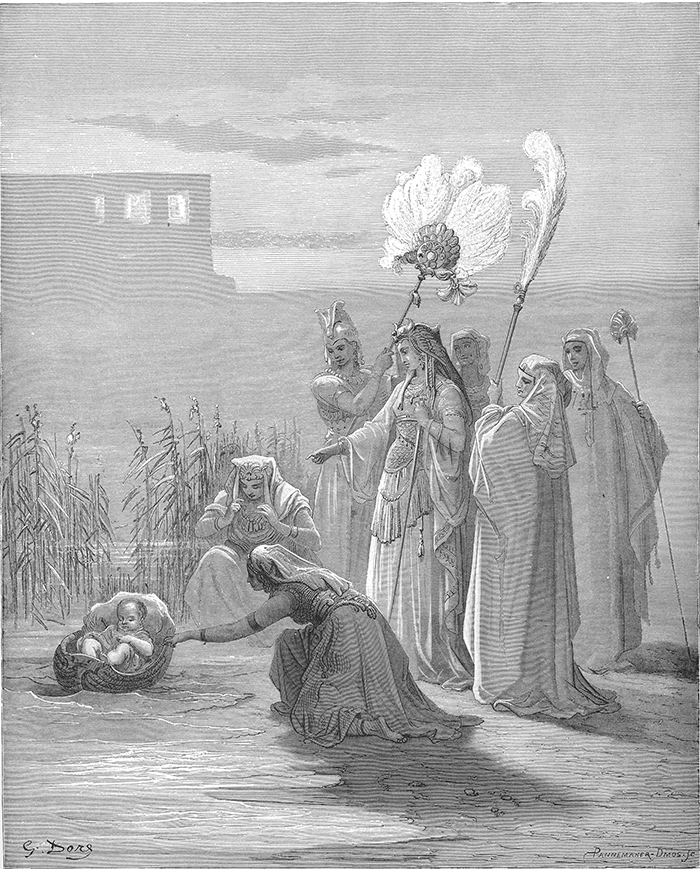

MOSES AND AARON’S AGES
7 Now Moses was eighty years old, and Aaron eighty-three years old, when they spoke to Pharaoh. Exodus 7:7
We learn that Moses was 80 years old and Aaron 83 when they purportedly endured the strenuous and grueling events of the Exodus. How plausible is it for an 80-year-old man to be doing the things attributed to Moses then and especially from that point forward.
Moses and Aaron were living in the harsh desert until he was 120 years old, at a time when the average lifespan of a man was 60?

MAGIC WANDS INTO SERPENTS
In the story about the battle of wits and brawn that follows, we are asked to accept the fact that Moses and Aaron and the Egyptian priests truly turned their staffs into serpents:
3 The Lord said, “Throw it on the ground.” Moses threw it on the ground and it became a snake, and he ran from it. Exod 4:3
10 So Moses and Aaron went to Pharaoh and did just as the Lord commanded. Aaron threw his staff down in front of Pharaoh and his officials, and it became a snake. Exodus 7:10
An impossible tale as “history” that finds the miraculous same story in pagan myths. As is the case with the exodus theme, many individual elements of the exodus drama we find the same story in other and often earlier texts and traditions.
Fig. 21. Gustave Doré, Moses and Aaron Before Pharaoh, 1866. (Doré’s English Bible)

JUST ANOTHER TYPICAL MAGICAL ROD
In producing assorted miracles, the prophet’s rod is not unique but represents a magical stick used by a number of other mythical characters, such as the Greek god Mercury/Hermes:
The caduceus or rod of Mercury is well known in poetic fables. It is another copy of the rod of Moses. He [Mercury/Hermes] is also reported to have wrought a multitude of miracles by this rod; and particularly he is said to kill and make alive, to send souls to the invisible world and bring them back from thence. Homer represents Mercury taking his rod to work miracles, precisely in the same way as God commands Moses to take his.
In this comparison, we see British theologian Rev. Dr. Adam Clarke (1760/2–1832) attempting to make the pagan account the copier of the Mosaic tale, when the opposite would be the case, or, perhaps, both drawing from the same, ancient mythical archetype.
Fig. 45. Benjamin West, The Brazen Serpent, 1790. BJU Art Gallery and Museum, Greenville, SC
The story of Hermes waking souls can be found in Homer’s Odyssey (24.1):
Now Cyllenian Hermes called forth from the halls the souls of the wooers, and he held in his hand his wand that is fair and golden, wherewith he lulls the eyes of men, of whomso he will, while others again he even wakens out of sleep.587
Thus, this motif existed in the literary record centuries before the Moses myth appears to have been composed. The borrowing is from paganism to Judaism. Here the Greek word for “wand” is rhabdos, the same term used in the LXX to describe Moses’s magical rod.
—-THE 10 PLAGUES——
The Exodus plagues could not have been historical. In his article “Redaction of the Plague Narrative in Exodus,” renown Jewish biblical scholar and Rabbi Dr. Moshe Greenberg (1928–2010) discusses the fact “there is considerable evidence that the present text is not of one writing piece.”
Greenberg shows that the narrative was composed in stages. Firstly with couplets totaling six plagues. Then later were added the other four. He also analyzes the fact that “some critics postulate three distinct narrative traditions in the plague story,” citing “P, J and E.”
Greenberg concludes that the
“plague narrative is the product of an elaborate growth of traditions…”
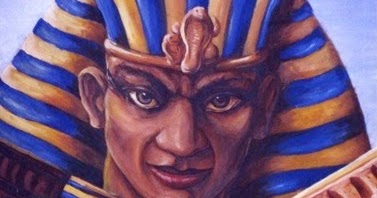
GOD CONTROLS THE PHARAOH
Exodus Chapters 7–12 contains details the 10 plagues. “God” hardens pharaoh’s heart so he will not let Moses’s people leave.
This makes Pharaoh not responsible. The responsibility goes to the doings of an evil God controlling another, the Pharaoh, by hardening his heart … against the Pharaoh’s will.

PLAGUE ONE
In the first plague all the water was turned to blood and that it killed all the fish in Egypt.
How could this singular event escape the notice of Egyptian writers or the many travelers from abroad? The death of all the fish, as well as the un-drinkability of water everywhere in Egypt, would lead to tremendous hardship that would resound well beyond the Egyptian borders. But, we hear not a word anywhere of such a “historical” events in any writing or literature of the time. Nor is there any solid, scientific proof of any extraordinary mass fish die-off or water spoiling at that time.
It states that God turned ALL the waters in the river to blood.
19 And the Lord said to Moses, “Say to Aaron, ‘Take your staff and stretch out your hand over the waters of Egypt, over their rivers, their canals, and their ponds, and all their pools of water, so that they may become blood, and there shall be blood throughout all the land of Egypt, even in vessels of wood and in vessels of stone.’” Exodus 7:19
But the Pharaoh magicians did the same. But there was no water throughout the land of Egypt for the magicians to turn to blood!!!
22 But the magicians of Egypt did the same by their secret arts. So Pharaoh’s heart remained hardened, and he would not listen to them, as the Lord had said. Exodus 7:22
But the Egyptians could dig wells next to the Nile river and that water was not affected. How convenient. I guess the “waters of Egypt” doesn’t include wells next to the Nile.
24 And all the Egyptians dug along the Nile to get drinking water, because they could not drink the water of the river. Exodus 7:24
All the other plagues have endings but this plague states no ending.
It would seem all the cattle would die from this plague. But they ALL die in plague five …. and cattle die again in plague seven (those left in the field) …. and again the first born of the cattle die in plague ten.
5 Every firstborn son in Egypt will die, from the firstborn son of Pharaoh, who sits on the throne, to the firstborn son of the female slave, who is at her hand mill, and all the firstborn of the cattle as well. Exodus 10:5

PLAGUE TWO – FROGS
Frogs “covered Egypt” during the second plague.
Again, there exists no historical account anywhere of such an extraordinary event. The economic cost of a pandemic frog invasion would be enormous, as would the potential illness when these hundreds of millions to trillions of frogs that died and had rotted away.
7 But the magicians did the same things by their secret arts; they also made frogs come up on the land of Egypt. Exodus 8:7
How did the magicians also bring frogs into the land when they were already everywhere???



PLAGUE THREE – LICE
The third plague, lice or gnats spread everywhere.
This pestilence might be considered “historical” only in the sense that lice and gnats thrive in Egypt and many other places globally. The Lord God purportedly was behind it and made it quite supernatural. If the lice/gnat infestation was beyond the norm to this extreme, one would think the Egyptians and other cultures would mention it somewhere in some writing. Again, such a pestilence would be very costly to their economy. There exists no written or scientific evidence for this claim.
18 But when the magicians tried to produce gnats by their secret arts, they could not. Since the gnats were on people and animals everywhere, 19 the magicians said to Pharaoh, “This is the finger of God.”
Lice, gnats, whatever it was. Finger of God??? You got to be kidding me!!! I can make hundreds from just a few in a mason jar. No magic to it.

PLAGUE FOUR – FLIES
A scourge of flies next covers Egypt.
Only Egypt proper is affected, and Moses later is able to stop this pestilence, proving that it is the supernatural Jewish Lord behind it.
Once more, there exists no scientific evidence that it happened. Many cultures in antiquity perceived a deity who controlled anything that flew, as was the role of the Philistine god Baal Zebub, “Lord of the Flies” or “Lord of Flying Things.” In this regard, it seems that each of these plagues may have been included by Yahweh in order to demonstrate the superiority of Yahweh as the controller of all these various elements.
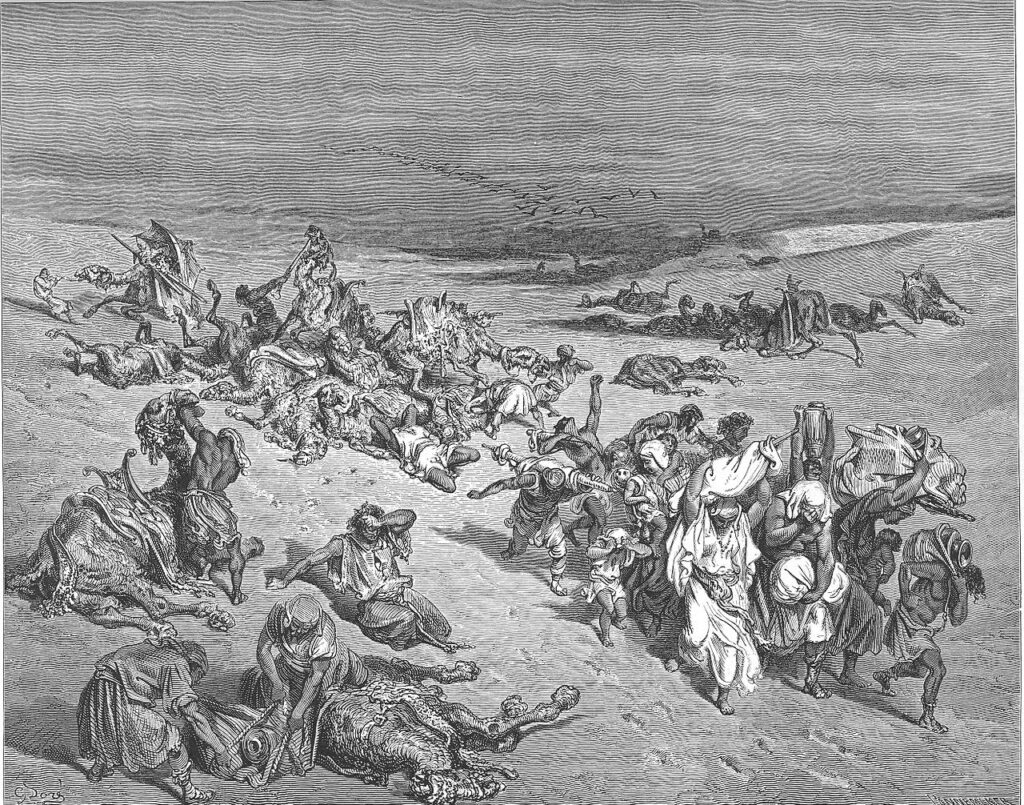
Fig. 22. Doré, The Murrain of Beasts, 1866. (Doré’s English Bible)
PLAGUE FIVE – CATTLE DIED
Livestock are beset with disease and ALL died during the fifth plague (Exod 9:3–6).
6 And the next day the Lord did it: All the livestock of the Egyptians died, but not one animal belonging to the Israelites died. Exodus 9:6
This punishment is directed at the innocent animals (horses, donkeys and camels and on your cattle, sheep and goats) belonging to the Egyptians but not to the animals belonging to the Hebrews confined to living in Goshen.
7 Pharaoh investigated and found that not even one of the animals of the Israelites had died. Yet his heart was unyielding and he would not let the people go. Exodus 9:7
Again, the economic cost would be staggering, a and no written or no scientific evidence has ever been found for this event. And cattle die in two more plagues that follow.

PLAGUE SIX – BOILS
God next abuses the people and beasts with incurable boils
Pharaoh’s heart couldn’t soften if he wanted to —because GOD hardened it in the first place. This sixth plague could not be natural, as how could it affect Egyptian beasts and Egyptians but not affect anything of the Hebrews?
If all of the Egyptian animals “beasts” were killed off during the fifth plague, what was left but house dogs and varmints, but they are not beasts. The believers may say the Egyptians bought livestock “beasts” from the Israelites quickly before this sixth plague.
Again, there is no written account of such an event in the Egyptian or other historical record, and this disaster would bring Egypt to its knees financially, as would the first five the country had already endured.
Why another 4 plagues??? Oh … I forgot …. they were added later because more drama was needed in the story.

PLAGUE SEVEN – HAIL
Next huge hailstones fell in Egypt.
18 Therefore, at this time tomorrow I will send the worst hailstorm that has ever fallen on Egypt, from the day it was founded till now. 19 Give an order now to bring your livestock and everything you have in the field to a place of shelter, because the hail will fall on every person and animal that has not been brought in and is still out in the field, and they will die.’” Exodus 9:18
Wait a minute!!! Livestock and everything in the field??? Didn’t the livestock and everything in the field die in plague five??? Did they all come back to life as an animal resurrection event??? Did they die twice???
This killing every living thing that remained outdoors, as if there could be anything outside now! Where did the all outside living locust come from so as to be the next plague.
The Hebrew area of Goshen remained unaffected as usual.
There is no writings, no evidence that “every living thing” was killed at any point in Egyptian history, whether by hail or any other means.

PLAGUE EIGHT – LOCUSTS
1 Now the Lord said to Moses, “Go in to Pharaoh; for I have hardened his heart and the hearts of his servants, that I may show these signs of Mine before him, Exodus 10:1
God again was hardening the victim Pharoah and his heart. Yet the Pharaoh appears to be consenting to Moses’s demands, even though his heart is being hardened by God.
10 Then he said to them, “The Lord had better be with you when I let you and your little ones go! Beware, for evil is ahead of you. 11 Not so! Go now, you who are men, and serve the Lord, for that is what you desired.” And they were driven out from Pharaoh’s presence.
12 Then the Lord said to Moses, “Stretch out your hand over the land of Egypt for the locusts, that they may come upon the land of Egypt, and eat every herb of the land—all that the hail has left.” 13 So Moses stretched out his rod over the land of Egypt, and the Lord brought an east wind on the land all that day and all that night. When it was morning, the east wind brought the locusts. Exodus 10:10-13
“God” and Moses apparently wants the conflict to go on so he relies on his trusty Magical Wand to make another plague, the locusts, happen to the Egyptians. This badly written story would definitely not make it past the script stage in Hollywood.
Locusts may seem plausible at first glance, since locust plagues are not uncommon in various regions.
Of course, Super-hero Moses was supernaturally controlling this plague by stretching forth his Magical Merlin Wand. And, he is also able to powerfully end the plagues upon request of the Pharaoh, by asking Yahweh to stop sending them.
Furthermore, the previous plague of hail would have killed much of the foliage (everything outside died), leaving nothing for the locusts to destroy.
And there was nothing for any cattle to eat.
Pharaoh still does not relent — even if he desperately wanted to — he can’t relent since the (righteous) Lord is controlling his “heart.”
PLAGUE NINE – DARKNESS
Next three days of darkness. The Pharaoh himself must have been so strong and resilient that he suffered and endured plague after plague.
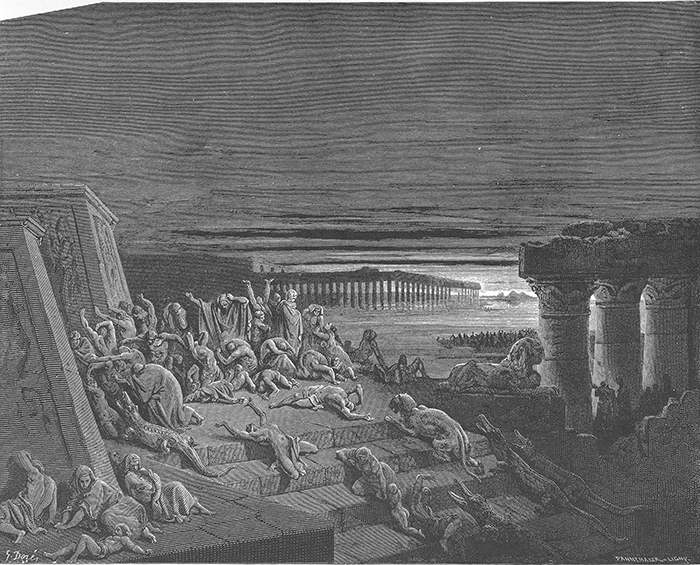
Fig. 23. Doré, The Plague of Darkness, 1866. (Doré’s English Bible)
Obviously, there is no written account of this three-day blackout. However this three-day period can be found in the myths happening in other cultures of other lands.
Scholar Wheless sensibly asks, if Egypt was plagued with three days of darkness, why did the Hebrews not flee under this cover, especially since they were the only ones who could see lights during that three day period.
23 No one could see anyone else or move about for three days. Yet all the Israelites had light in the places where they lived. Exodus 10:23
THREE DAYS OF DARKNESS
One of the biblical plagues, the motif of three days of darkness, sounds as if it has been taken from a solar myth, in which the sun is deemed at the winter solstice both to “stand still” for three days and to be in the “womb of the night,” as the days are the shortest of the year. In a similar vein, the theme of the sun standing still in the biblical story of Joshua, as well as Moses in the Talmud, also represents the solstice, from the Latin words sol and sistere, meaning “sun stands still.”
13 So the sun stood still,
And the moon stopped,
Till the people had revenge
Upon their enemies. Jos 10:13
Fig. 46. Joshua commanding the sun to stand still. (Treasures of the Bible, 1894)
Rather than serving as a special instance of Yahweh’s wrath, the Exodus plagues constitute but one such biblical episode, as the Good Book is full of such divine retribution, against both the enemies of the Israelites and also the Isrealites themselves. Some of the historical plagues in the Levant during the centuries prior to the myth’s composition could have been used in the text, along with the observation of muddy, red waters in flooded rivers like the Adonis or Nile. But these facts still would not make the Exodus itself a “true story.”
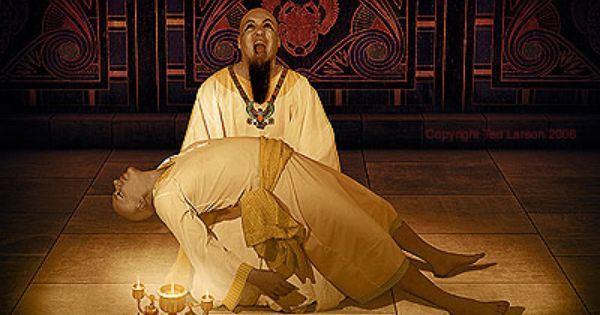
Fig. 24. Egypt’s firstborn destroyed. (de Hondt, Figures de la Bible, 1728)
PLAGUE TEN (LAST) – FIRST BORN SLAUGHTERED
Finally, the 10th plague (Exod 12:12–29). Ten, what a nice round number. This is the infamous plague event commemorating what is today called the Passover.
The killing of all first-born of the Egyptian humans and first born of living livestock of the Egyptians is the tenth plague event.
Did the Egyptians still have any livestock after plague five where all their livestock died??? And of course the Israelites were exempted. They and their livestock escaped any deaths because they put a protective mark in lamb’s blood upon their doors and God knew what cattle they owned. Or maybe the Isrealites also put blood on the entryways of their livestock to spare first born of their cattle from being slaughtered.
Why does an all knowing God need to know which houses to “pass over” by seeing blood on the door posts???
And remember the Egyptians only allowed Isrealites to live in their exclusively Isrealite community of Goshen. There were no Egyptian families living in Goshen for the Angel of Death to pass over. There was no need for the blood on the door posts. God didn’t need any blood on the doorposts of the livestock to passover in plague five when he spared all the Isrealite cattle in Goshen.
250,000 LAMBS
Again, whence did the Israelites immediately obtain a minimum estimated 250,000 or so lambs or goats necessary for this mass sacrifice to feed three million plus people. How did they communicate this event in an era long before there were telephones, phone texting, internet, email, social or other mass media. Additionally, if all the Egyptian animals had already been killed in the other plagues, so all the special 250,000 lambs or goats had to all come from the Israelites.
And .. not just any animal, the sacrificial animals had to be either a lamb or goat, had to be a male, one year old, and without blemish.
2 “This month will be the first month; it will be the first month of the year for you. 3 Tell the whole Israelite community: On the tenth day of this month they must take a lamb for each household, a lamb per house. 4 If a household is too small for a lamb, it should share one with a neighbor nearby. You should divide the lamb in proportion to the number of people who will be eating it. 5 Your lamb should be a flawless year-old male. You may take it from the sheep or from the goats. 6 You should keep close watch over it until the fourteenth day of this month. At twilight on that day, the whole assembled Israelite community should slaughter their lambs. Exod 12:2-6
The genocide Plague;
29 At midnight the Lord struck down all the firstborn in Egypt, from the firstborn of Pharaoh, who sat on the throne, to the firstborn of the prisoner, who was in the dungeon, and the firstborn of all the livestock as well. Exod 12:29
Wait, wasn’t all the first born livestock dead from two previous plagues??? This is the third time the cattle are struck dead???
Like the other plagues, this episode of the slaughter by God of the firstborn of Egypt, both human and animal, is never mentioned in any historical record anywhere is the world.
If such a massively traumatic event had occurred, the Egyptians surely would have felt a huge ripple effect in their very social structure. Thousands of people and animals would have died suddenly, and the survivors would likely have feared the Israelite god and incorporated this particular god worship into their pantheon. However, we find nothing of the sort happened.
SIX PLAGUES GREW TO 10
The Exodus plagues could not have been historical. In his article “Redaction of the Plague Narrative in Exodus,” biblical scholar and Rabbi Dr. Moshe Greenberg (1928–2010) discusses the fact and states;
“there is considerable evidence that the present text is not of one writing piece.”
Greenberg shows that the narrative was composed in stages. Firstly with couplets totaling six plagues, then later were added the last four.
He also analyzes the fact that “some critics postulate three distinct narrative traditions in the plague story,” citing “P, J and E.” Greenberg concludes;
“The plague narrative is the product of an elaborate growth of traditions…”
GOD IS A SERIAL MURDERER! (WHAT A JOKE OF A STORY!)
In criminal law if one causes another person to act a certain way to further his criminal objectives then the person acting is not responsible and liability is imposed on the person causing the unwilling act. Here God hardened Pharaoh’s heart making him do what God wanted him to do an not what the pharaoh would have done on his own. Then God slaughtered, murdered thousands of innocent humans and animals. Why the first born? I guess God thinks that is the most valuable of the humans and livestock. Another example of a depraved mind. And why the first born of the animals??? What have they done wrong???
What kind of Evil God is this to cause such murders? The plagues story ranks as a horrible tale of an Evil God. If one were the all-powerful God, why not just snap one’s fingers and simply remove the Israelites to the Promised Land?
And what about all the innocent animals (horses, donkeys, camels, cattle, sheep and goats) God killed? What is the purpose of the animal deaths???
Furthermore, why in the first place did the omnipotent God allow Israel to serve as captives in Egypt for six hundred years before sending Super-hero Moses along?
Why would God go to all the trouble and cause so much hardship and suffering? These stories are “objective lessons” put out by humans trying to make other stupid dummies (people) follow them. These are not historical facts, and NOT God’s doings!!! As the myth it serves as a cultural artifact that can be found in the myths of other cultures as well.
EGYPTIAN POPULATION
In addition, the Egyptian population itself, throughout the entire nation, was only an estimated three to three and a half million, so how could there be such an enormous population of “slaves of two and a half to three million slaves???”
After the utter decimation of the Egyptians by Yahweh, why would the “slaves” need to flee and from whom would they be escaping? Who would pursue them at that point? Who would keep them in the land and in thrall?
If Egypt were so devastated, with nearly every living thing killed, including many able-bodied men, it would be easy for the three million of spared Hebrews to overwhelm the remnants of the Egyptians and take over the entire country, rather than fleeing into the relatively poor and inhospitable wilderness.
As we can see, the plagues story is hopeless as “history,” but there have been attempts to trace these episodes to the eruption of the Greek island of Santorini or Thera, which apparently occurred around 1600 BCE. While some of these efforts may appear exhaustive, and while it is tempting to look in the historical record for such a massive event, which would have affected life around the Mediterranean for years, this argument remains unconvincing for the many reasons stated above, such as when the Exodus tale itself first appears in the historical record and the obvious use of allegorical biblical verses in its construction. Another major reason to suggest the plagues tale as myth—pagan pestilence mythology.

MASS COMMUNICATION
It must be asked further how the Israelites knew to leave Egypt and to take the booty from their Egyptian neighbors (Exod 12:35), since it would require a very long time for any message passed mouth to ear to spread through the households of hundreds of thousands. Exodus tells us that this feat of organizing all these people and animals, for their departure from Egypt, required only one day:
And at the end of four hundred and thirty years, on that very day, all the hosts of the LORD went out from the land of Egypt….Exodus 12:41
and on that very day the LORD brought the people of Israel out of the land of Egypt by their hosts. Exodus 12:51
It is extremely unlikely that such an event with so massive a population could have occurred in a single day. Not even with our modern technology could such a “flash mob” be put together in that time.
NO FORMAL ORGANIZATION
According to the Bible, the Israelites had no formal and centralized organization until after they were already settled in the desert. How could any of the Exodus events have been organized, with millions all wandering around aimlessly with no chain of command?
Moreover, the military training of the hundreds of thousands of Israelite “warriors” (who were raised as slaves) does not occur until after they arrive at Mt. Sinai, although Exodus claims the Israelites left Egypt “equipped for battle.” How could Moses have executed “brilliant” military tactics with a mass of untrained fighters? Where did these supposed “slaves” learn these military tactics, then, and obtain their enormous amount of weapons?
18 So God led the people around by the desert road toward the Red Sea. The Israelites went up out of Egypt ready for battle. Exodus 13:18
Such a massive force on the move would surely have left some mark on the desert. Yet, despite the wishful attempts by various devout researchers, not a single unambiguous and no scientifically verified artifact has ever been found from such a vast and long-term migration.
UNLEAVENED BREAD
We read about the unleavened bread ( מצות matstsah) and bitter herbs ( מרר mĕror) to be eaten as Passover, before the Israelites flee Egypt. Unleavened Bread as representing a “real Exodus” in which the Israelites fled so quickly that they did not have time for their bread to rise are simplistic. It is a conditioning of the people to command them to:
8 That same night they are to eat the meat roasted over the fire, along with bitter herbs, and bread made without yeast. Exodus 12:8
No leaven bread is to be eaten for 7 days to commemorate this tale as being real again using food to condition people. Also there is a no work festival on the first and seventh day to further con this myth as being real history.
The Bible (Gen 19:3) records the use of unleavened bread by Abram’s nephew, Lot, centuries earlier, according to the story. Moreover, the Egyptian religion had its own “unleavened bread” in the form of “buns,” which were “unleavened, like the shewbread of the Hebrews, eaten by Isrealite priests only, and offered to them in piles.”
240,000 LAMBS SLAUGHTERED IN ONE NIGHT
Add to this tale a couple hundred thousand animals, as well as the mass of booty supposedly acquired from the Egyptians, and the tale become even more implausible. How was this huge amount of animals fed in the desert? What plant matter would they be able to eat, in the enormous quantities needed?
Additionally, how could this huge mass of livestock have been pastured in Egypt to begin with? Wheless calculates that the amount of lambs needed to fulfill the Passover decree at Exodus 12:21 would be something on the order of at least 240,000, slaughtered in one night. If those were only the lambs, how many other animals were there, including all the adult sheep, cattle, goats and horses, all spared miraculously during the plagues?
Wheless also calculates that the pasture lands needed for such a mass would be equivalent to the size of the American state of Rhode Island.
21 Then Moses summoned all the elders of Israel and said to them, “Go at once and select the animals for your families and slaughter the Passover lamb. Exodus 12:21
BOOTY
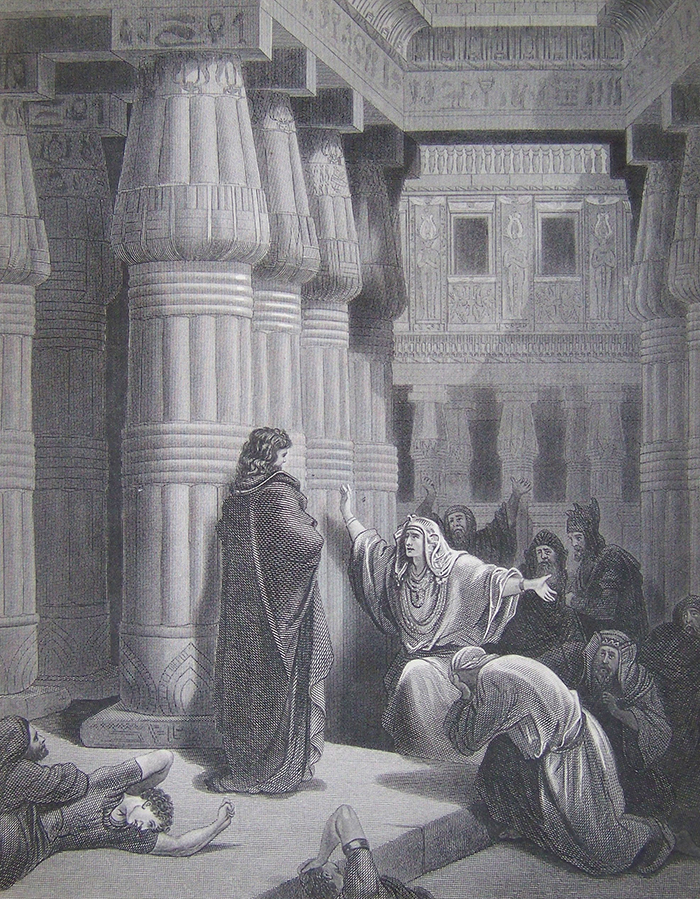
Egyptians pleading with Moses to depart with their riches.
At Exodus 3:22 and 12:35, the Israelites are to flee through the desert with the enormous wealth of Egypt, taking a mass of silver and gold. Why carry all that weight to live in the desert, where it has no value? Could not Yahweh instantly transport the gold and silver into a safer place in Israel? Was he not capable of hiding it and giving it to the Israelites later? Why would they need this wealth in the first place, since Yahweh is purported to be omnipotent and able to take care of all their needs?
22 Every woman is to ask her neighbor and any woman living in her house for articles of silver and gold and for clothing, which you will put on your sons and daughters. And so you will plunder the Egyptians.” Exodus 3:22
35 The Israelites did as Moses instructed and asked the Egyptians for articles of silver and gold and for clothing. Exodus 12:35
Moreover, such an amount of pillaged booty would leave the nation of Egypt bankrupt and destitute, and the Israelites extremely wealthy, a situation not borne out by the historical and archaeological record. Archaeologists have found no evidence of such wealth among the hill settlers who became the Israelites.
EXODUS WAS WRITTEN BY OTHER HISTORIANS
In regard to the children of Israel going out from the land of Egypt, we have no doubt that such an occurrence took place, although not in the manner, and not for such reasons, as is recorded by the sacred historian. We find, from other sources, what is evidently nearer the truth.
It is related by the historian Choeremon, that, at one time, the land of Egypt was infested with disease, and through the advice of the sacred scribe Phritiphantes, the king caused the infected people (who were none other than the brick-making slaves, known as the children of Israel), to be collected, and driven out of the country.
Lysimachus relates that:
“A filthy disease broke out in Egypt, and the Oracle of Ammon, being consulted on the occasion, commanded the king to purify the land by driving out the Jews (who were infected with leprosy, &c.), a race of men who were hateful to the Gods.” ” The whole multitude of the people were accordingly collected and driven out into the wilderness.”
Diodorus Siculus, referring to this event, says:
“In ancient times Egypt was afflicted with a great plague, which was attributed to the anger of God, on account of the multitude of foreigners in Egypt: by whom the rites of the native religion were neglected. The Egyptians accordingly drove them out. The most noble of them went under Cadmus and Danaus to Greece, but the greater number followed Moses, a wise and valiant leader, to Palestine.”
After giving the different opinions concerning the origin of the Jewish nation, Tacitus, the Roman historian, says:
“In this clash of opinions, one point seems to be universally admitted. A pestilential disease, disfiguring the race of man, and making the body an object of loathsome deformity, spread all over Egypt. Bocchoris, at that time the reigning monarch, consulted the oracle of Jupiter Hammon, and received for answer, that the kingdom must be purified, by exterminating the infected multitude, as a race of men detested by the gods. After diligent search, the wretched sufferers were collected together, and in a wild and barren desert abandoned to their misery. In that distress, while the vulgar herd was sunk in deep despair, Moses, one of their number, reminded them, that, by the wisdom of his councils, they had been already rescued out of impending danger. Deserted as they were by men and gods, he told them, that if they did not repose their confidence in him, as their chief by divine commission, they had no resource left. His offer was accepted. Their march began, they knew not whither. Want of water was their chief distress. Worn out with fatigue, they lay stretched on the bare earth, heart broken, ready to expire, when a troop of wild asses, returning from pasture, went up the steep ascent of a rock covered with a grove of trees. The verdure of the herbage round the place suggested the idea of springs near at hand. Moses traced the steps of the animals, and discovered a plentiful vein of water. By this relief the fainting multitude was raised from despair. They pursued their journey for six days without intermission. On the seventh day they made halt, and, having expelled the natives, took possession of the country, where they built their city, and dedicated their temple.”
A similar account was given by Manetho, an Egyptian priest, which is referred to by Josephus, the Jewish historian. The main points are the same.
ONLY 7,000 MALES
There exists no evidence for the Exodus and wandering in the desert as historical. To begin with, Wheless’s lengthy analysis shows the impossibility of even 600,000 male descendants of Jacob (from only 70) during the alleged four generations of the Hebrew sojourn in Egypt (Gen 46). He calculates that the most the Hebrews in Egypt could have produced over those generations would be fewer than 7,000 males.
5 The descendants of Jacob numbered seventy in all; Joseph was already in Egypt. Exodus 1:5
Putting aside for the moment the non-existent literary or archaeological records or artifacts for the events in the Pentateuch, let us analize the story itself for its merits as “history” even if we grant the totally impossible number of two to three million Hebrews in the time since Jacob entered Egypt.
1500 MILES
Marching single file, about 2,000 people will fit comfortably into a mile, with no belongings and little space between them. If three million people—not just the 600,000 men mentioned in the Bible but also women, children and non-Hebrew men, among them the Israelites’ own slaves:
37 The Israelites journeyed from Rameses to Sukkoth. There were about six hundred thousand men on foot, besides women and children Exod 12:37
If the Israelite men alone were lined up single file, the route would require an estimated 1,500 miles. In order to fit into the 130-mile-broad Sinai, the Israelites would need to line up more than 10 abreast, without belongings such as wagons and animals.
The Septuagint of Exodus (LXX 13:18) says:
“children of Israel went up by five in a rank out of the land of Egypt,”
At two to three million individuals, has been calculated to equal a column of people some 280 miles long, more than twice the width of the desert. That is not including their carts and animals.
==>600,000 MYTHICAL NUMBER CLICK HERE <==
MODERN GATHERINGS
One argument seeks to prove that this large number of people could have fit into the 130-mile-wide Sinai Peninsula, because in the modern era we have rock concerts, religious gatherings such as at the Vatican, and political rallies that number in the hundreds of thousands to millions.
In the first place, these modern events are temporary gatherings, not 40 years of attempting to live in such a space. Nor do these modern mass meetings try to move a couple of hundred miles or so through a desert, with hundreds of thousands of animals, carts and other belongings, such as gold and a vast treasure.
Secondly, today we benefit from modern technology that provides resources for such temporary gatherings; we cannot rely on God to supply manna and water miraculously. And how would all those people fare socially with each other under such conditions for four decades? Modern events do not involve long-term co-habitation.
The bottom line is that, while such numbers may be sustainable in cities with modern technology, as in the case of Mexico City, New York, Tokyo and so on, again there are no large amounts of animals, and the people are not living in tents in a desert, depending on God provided food and water.
NOT FOR ONE YEAR JOURNEY – BUT FORTY
Why is it that the Israelites could not have continued their shoulder-to-shoulder march into the Promised Land but required 40 years to cross this desert, except that the period is described biblically as a time of conditioning the “chosen people” to follow the Mosaic law:
13 The Lord’s anger burned against Israel and he made them wander in the wilderness forty years, until the whole generation of those who had done evil in his sight was gone. Num 32:13

FORTY YEARS OF GOD’S DESERT TRAUMATIZATION
According to the Exodus story, millions of escaped slaves were traumatized and tortured in the desert for four decades by Yahweh playing all manner of scary tricks and mind games on them. If the tale were true, such behavior would be condemnable as the practice of a bizarre and anti-human cult with an evil god. If the “chosen people” were so “stiff-necked” that they needed 40 years of being terrorized and abused in the desert, while experiencing astonished mind-bending miracles, one wonders why the all-powerful God would choose these people in the first place.
We would consider such a cult leader to be completely sinister who takes his followers out into the desert and subjects them to severe deprivations and interchangeably terrorizes and astonishes them, all for the purpose of training them to be obedient. What kind of “father” would such a tyrant be? Moreover, knowing that the Promised Land was not far away, is it truly logical that not a single Israelite escaped the Moses’s cult, during the entire 40-year period in the desert?